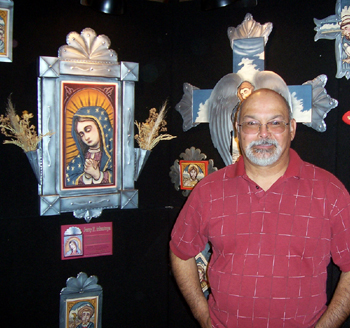 |
 |
Spanish
Colonial Art
Spanish
Colonial Art
In 1598 the first Spanish Colony was established in New Spain (New
Mexico, U.S.A.). By the 1700's the Art of the Santero (saint maker) was
born and had emerged to provide spiritual art to the lay people of
Nueva Espana. This art form was greatly influenced by the European
Baroque Style which was introduced by the Franciscan priests and
clergy. Indigenous people of New Mexico had now begun to produce
beautiful spiritual art, but not with the finest marble, plaster and
gold like their predecessors but with material that was native to their
land.
Pine and cedar trees were used to carve alters and saints and gypsum
plaster and rabbit hide glue were combined to produce gesso (white
wash) as a base for painting. The Chamisa plant (yellow), Indigo flower
(blue), and Cochineal bug (red) were the primary colors. The fruit of
the Yucca plant was used as the vehicle in which these rich pigments
flowed. Pinon sap was used as glue and varnish to protect their holy
art. And finally wheat straw and tin (poor man's silver and gold) were
used to embellish.
Jerry's Santos are all produced with the same materials these Santeros
used 400 years ago. Although his style is more contemporary, homemade
gesso, natural pigments and pinon sap varnish along with tin and straw
applique are the foundation of his
devotional art. |
|
 |
|











